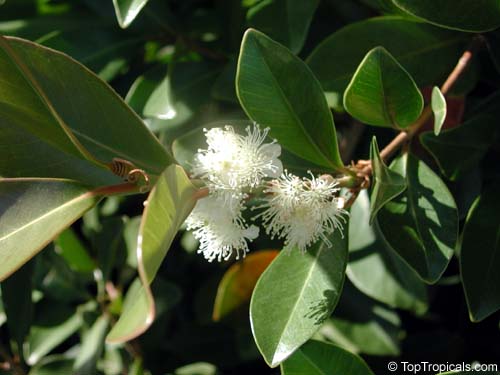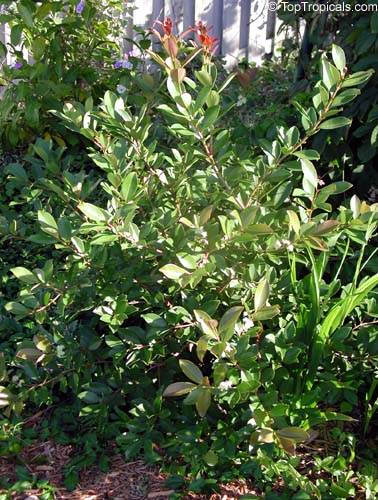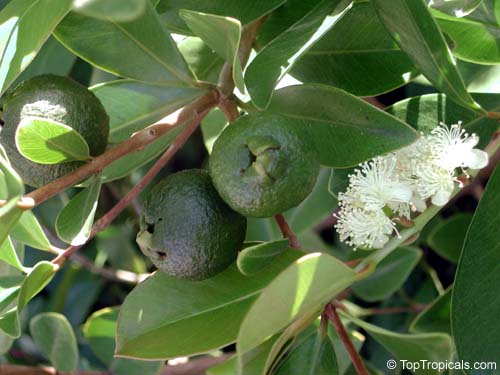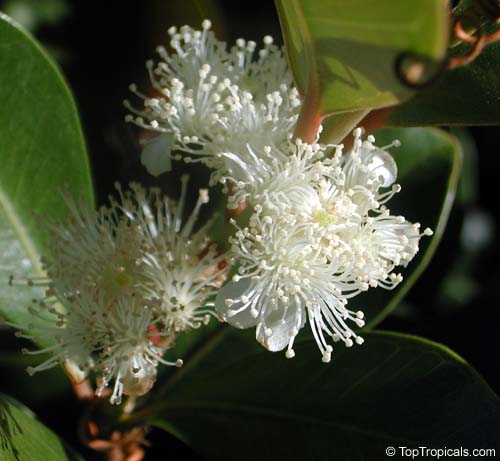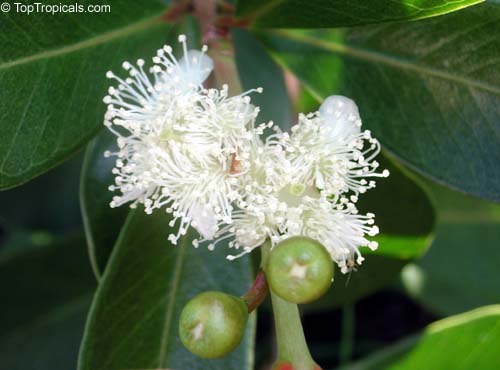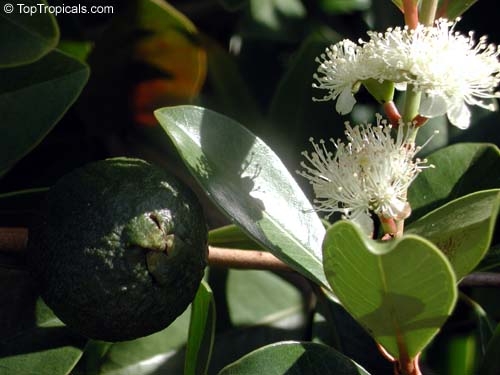TROPICAL GUAVA - Psidium guajava, P. littorale (family: Myrtaceae)
click on image to enlarge
Common Names
Guava, guyava, kuawa.
Ethnic names
Guava, Goiaba, Guayaba, Djamboe, Djambu, Goavier, Gouyave, Goyave, Goyavier, Perala, Bayawas, Dipajaya Jambu, Petokal, Tokal
Origin
The place of origin of the guava is uncertain, but it is believed to be an area extending from southern Mexico into or through Central America. It is believed that Guava may have been domesticated in Peru several thousand years ago where Peruvian archaeological sites have been uncovered with guava seeds found stored with beans, corn, squash and other cultivated plants. It has been spread by man, birds and other animals to all warm areas of tropical America and in the West Indies (since 1526). Centuries ago, European adventurers, traders and missionaries in the Amazon Basin took the much enjoyed and tasty fruits to Africa, Asia, India and the Pacific topical regions where it is now cultivated throughout the tropical regions of the world.
Guava has spread widely throughout the tropics with moderate to heavy rainfall because it thrives on a variety of soils, propagates easily and bears fruit relatively quickly. The fruits contain numerous seeds that can produce a mature fruit-bearing plant within four years. In the Amazon rainforest, the seeds of guava fruits are much enjoyed by birds and monkeys, which disperse guava seeds in their droppings and causing spontaneous clumps of guava trees growing through the Amazon Rainforest.
Temperature
Temperature Zone 9b-11. Needs some frost protection, foliage damaged at 28° F (-2° C), serious damage or death at 26° F (-3° C). The tree will recover from a brief exposure to 29° F but may be completely defoliated. Young trees are particularly sensitive to cold spells. Older trees, killed to the ground, have sent up new shoots which fruited 2 years later. Overhead protection and planting on the warm side of a building or structure will often provide suitable frost protection for guavas in cooler areas. A frame over the plant covered with fabric will provide additional protection during freezes, and electric lights can be included for added warmth. Potted plants can be moved to a more protected site if necessary.
Sun Exposure
Full sun to light shade
Watering Needs
A warm, humid condition is most optimum for guavas, although they thrive in both humid and dry climates and can take considerable neglect, withstanding temporary waterlogging and very high temperatures. They have survived dry summers with no water, although they do best with regular deep watering. The ground should be allowed to dry to a depth of several inches before watering again. Although the guava can tolerate low moisture condition, availability of water constantly will promote fast growth and leaf flushes. Lack of moisture will delay bloom and cause the fruit to drop.
Soil
The guava will tolerate many soil conditions, but will produce better in rich soils high in organic matter. Loam and alluvial types of soil is most ideal. They also prefer a well-drained soil in the pH range of 5 to 7. The tree will take temporary waterlogging but will not tolerate salty soils.
Growth Habit
Guavas are evergreen or semideciduous, shallow-rooted shrubs or small
trees 6 to 25 feet high (1.8 to 7.5 m), with spreading branches. Some
varieties may reach 40 feet (12 m) under favorable conditions. In the
richness of the Amazon, Guava fruits often grow well beyond the size
of tennis balls on well branched trees or shrubs reaching up to 20 meters
in height.
The trunk is slender with a smooth, mottled green or reddish brown scaly
bark which peels off in thin flakes to reveal the attractive "bony"
aspect of its trunk. The plant branches close to the ground and often
produces suckers from roots near the base of the trunk. Young twigs
are quadrangular and downy.
Foliage
Guava leaves leaves are opposite, short-petioled, oval or oblong-elliptic, somewhat irregular in outline, 2 - 6 inches long and 1 - 2 inches wide. The dull-green, stiff but leathery leaves have pronounced veins, and are slightly downy on the underside. Crushed leaves are aromatic.
Blooming Habits
The flowers are either solitary . The fragrant greenish white to white flowers, 1 inch (2.5 cm) across, bear numerous yellow stamens, borne singly or in clusters of two or three, arising from the leaf axils of younger branches. They are 1 inch wide, with 4 or 5 white petals. These petals are quickly shed, leaving a prominent tuft of perhaps 250 white stamens tipped with pale-yellow anthers. The calyx lobes usually persist until the fruit ripens.
Fruiting Habits
Guavas are primarily self-fruitful, although some strains seem to produce more fruit when cross-pollinated with another variety. Guavas can bloom throughout the year in mild-winter areas, but the heaviest bloom occurs with the onset of warm weather in the spring. The exact time can vary from year to year depending on weather. The chief pollinator of guavas is the honeybee.
In shape, size and other characteristics, the fruits of the numerous
varieties are extremely variable. They may be round, globular, ovoid,
or pear shaped and from 1 to 6 inches in length (3 to 15 cm) and have
4 or 5 protruding floral remnants (sepals) at the apex. In color, the
skin may be greenish white, yellowish, or pink. The flesh may be white,
pink, yellow, or red. The outer layer of flesh is a finely granular
pulp; the inside is softer pulp with many small hard seeds. The sweet,
musky odor is pungent and penetrating. In flavor, varieties range from
sweet to tart, all with the characteristic musky flavor and odor of
the guava more or less pronounced. Fruits also vary in the thickness
of the fleshy mesocarp, which in some varieties is extremely thin. Varieties
differ widely in flavor and seediness, some are seedless. The better
varieties are soft when ripe, creamy in texture with a rind that softens
to be fully edible.
Upon ripening, the guava becomes soft and juicy. It may be eaten fresh,
made into a juice or nectar contain fruit pulp, or made into preserves,
jam, jelly, or paste. The guava is an excellent source of C vitamin.
In warmer regions guavas will ripen all year. There is a distinctive
change in the color and aroma of the guava that has ripened. For the
best flavor, allow fruit to ripen on the tree. The can also be picked
green-mature and allowed to ripen off the tree at room temperature.
Placing the fruit in a brown paper bag with a banana or apple will hasten
ripening. Mature green fruit can be stored for two to five weeks at
temperature between 46° and 50° F and relative humidity of 85 to 95
percent. Fruit that has changed color cannot be stored for any extended
periods. It bruises easily and will quickly deteriorate or rot. Commercial
juice varieties have rock hard inedible seeds, deep pink flesh and hard
yellow rinds. They are not good for eating out of hand but have extremely
high vitamin C content. The quality of the fruit of guavas grown in
cooler areas is often disappointing.
Seeds
Most varieties bear many seeds embedded in the soft pulp of the center. The seeds are numerous but small and, in good varieties, fully edible. Actual seed counts have ranged from 112 to 535.
Propagation
The guava may be propagated by cuttings, grafting, air layering, but
is commonly grown from seed. The disadvantage of the latter method is
that seedlings do not always reproduce the characteristics of the parent.
Guava seed remain viable for many months. They often germinate in 2
- 3 weeks but may take as long as 8 weeks. Seedlings bear fruit during
the second year. Since guavas cannot be depended upon to come true from
seed, vegetative propagation is widely practiced. They are not easy
to graft, but satisfactory techniques have been worked out for patch-budding
by the Forkert Method (probably the most reliable method), side-veneer
grafting, approach grafting and marcotting.
Anyway, though guava is easily grown from seeds, the seedling trees
are variable in fruit quality and take longer to fruit. Propogation
is also largely by vegetative means and the most satisfactory method
is budding. In budgrafting the stock plants are first sown from seeds
directly into individual polythene bags. After they have attained pencil
size the stock plants are ready for grafting. The grafted seedling is
ready for transplanting 2 - 3 months later. The planting distance is
usually 3m x 3m. Planting holes of 0.6m x 0.6m x 0.6m are dug and into
each hole is incorporated organic manure and Christmas Island Rock Phosphate
(CIRP). Shade is provided for the young plants immediately after planting
and watering is done regularly during dry weather until the trees are
well established.
The tree can also be grown from root cuttings. Pieces of any roots except
the smallest and the very large, cut into 5 - 10 inch lengths, are placed
flat in a prepared bed and covered with 2 - 4 inches of soil, which
must be kept moist. They may also be grown by air-layering or from cuttings
of half-ripened wood. Pieces 1/4 - 1/2 inch will root with bottom heat
and rooting-hormone treatment. Trees grown from cuttings or air-layering
have no taproot, however, and are apt to be blown down in the first
2 or 3 years. One of the difficulties with budded and grafted guavas
is the production of water sprouts and suckers from the rootstocks.
Related species
Brazilian guava, Guisaro (Psidium guinense Sw.), Cattley Guava, Strawberry Guava (P. cattleianum Sabine), Costa Rican Guava (P. friedrichsthalianum Ndz.), Para Guava (P. acutangulum DC.), Rumberry, Guavaberry (Myrciaria floribunda Berg.).
Adaptation
The tropical guava is best adapted to the warm climate of Florida and Hawaii, although it can be grown in coastal Southern California, and with some protection, selected areas north to Mendocino County. They tend to bear fruit better in areas with a definite winter or cooler season. The adaptability of the guava makes it a serious weed tree in some tropical areas. The smaller guava cultivars can make an excellent container specimen.
Pruning
Shaping the tree and removing water shoots and suckers are usually all that is necessary. Guavas can take heavy pruning, however, and can be used as informal hedges or screens. Since the fruit is borne on new growth, pruning does not interfere with next years crop. In fact, guava needs constant training and pruning both to provide the desired tree shape for ease of management and for the health of the tree and to maximise fruit production. The tree is usually trained 3 to 4 months after field planting. The open heart, open center, or cup-shaped pruning and training system is the best.
Fertilization
Guavas are fast growers and heavy feeders, and benefit from regular applications of fertilizer. Mature trees may require as much as 1/2 pound actual nitrogen per year. Apply fertilizer monthly, just prior to heavy pruning. For the first two years a composition of N:P:K in the ratio of 15:15:15 is recommended and from the third year onwards a composition of N:P:K:Mg in the ratio of 12:12:17:2+TE.
Weeding
The trees are circle-weeded every three months during the first three years. This can be done manually, by motorised grass cutter or herbicide.
Pests and diseases
A number of pests attack the guava such as the fruit fly, thrips, mealy
bugs, scale insects, spider mites, aphids etc. Fruit flies are most
important group of pests which attack guava. They are attracted to the
maturing fruit where they deposit their eggs. The eggs hatch and develop
within the fruit, causing a break down of the fruit tissue. Control
measures are field hygiene, bagging, use of poisoned baits and appplication
of insecticides such as lebaycid.
Fruit scabs affect immature fruits by causing a corky brown layer all
over the fruits. This will cause the fruits to be unattractive and unmarketable.
Parasitic algae causes rust-like blemishes on the fruit surface. When
the algae disappears, dark necrotic blemishes are left on the fruit
surface.
Foliage diseases, such as anthracnose, can be a problem in humid climates.
They can be controlled with regular fungicide applications. Where present,
root-rot nematodes will reduce plant vigor. Guava whitefly, guava moth
and Caribbean fruit fly can be major problems in southern Florida, but
have not been reported in California. Mealy-bugs, scale, common white
flies and thrips can be problems in California. In some tropical countries
the where fruit flies are a problem, the fruit is covered when small
with paper sacks to protect it and assure prime quality fruits for the
markets.
Suitable fungicides and pruning will help to reduce these diseases.
Harvesting and commercial potential
Guava fruit today is considered minor in terms of world trade but is
nevertheless widely grown in the tropics, enriching the diet of hundreds
of millions of people in the tropics of the world. Guavas are the only
commercially significant myrtaceous fruit. It is an important fruit
in many parts of the world suitable for its production. Guava is one
of the leading fruits of Mexico. Commercial producation of guava in
Hawaii and Florida is hampered by the presence of fruit flies. California
is too cool except for a few selected sites.
Guava is well distributed throughout the tropics and subtropics.
In Malaysia guava is available throughout the year although not always
in the same quantities.
Budded guava fruit within a year of planting. From flowering the fruits
take about three months to mature. Young fruits are bagged when about
one and a half month old. This not only protects them from fruit fly
attack but also improves their color and protects them from abrasion
during fruit development.
Guava fruits are harvested when they change color from green to light
green. This change in color occurs 90 - 150 days after flowering, depending
on the cultivar. The fruits are harvested manually, using pruning shears.
Harvesting intervals should not exceed 3 - 4 days or otherwise losses
from over- ripe fruits occur. In Malaysia important guava growing areas
are located in the states of Perak, Johore, Selangor and Negri Sembilan.
Other states of lesser importance are Malacca, Kelantan, Trengganu,
Perlis, Kedah, Pahang, Sabah and Sarawak.
The yield may start at 10 tonnes per hectare in the third year of production
and increase to 30 tonnes per hectare after the tenth year.
Properties/Actions
Antimicrobial, Astringent, Bactericide, Cicatrizant, Emmenagogue, Hypoglycemic, Laxative, Nutritive, Spasmolytic
Chemistry
Sugars: Carbohydrates are the principal nonaqueous constituents
of guava totalling about 14.8 g/ 100 g of fruit pulp. Of this nearly
6 g is made up of fructose (58.9%), glucose (35.7) and sucrose( 5.3%).
Acids: The total acidity of a range of guavas has been quoted
as between 14-18 mg per 100 g and ascorbic acid was found to vary between
62-364 mg/ 100 g. The tartness of guavas has been acsribed to the pH
of around 3-4 which comes about largely due to the presence of malic
and citric acids.
Pigments: The lycopene content of the Beaumont variety has been
found to be about 5-7 mg/100 g fruit. This gives rise to the pink coloration.
Volatiles: Over 150 compounds have been identified in the volatile
flavour constituents of guavas. Some of these include: benzaldehyde,
alpha-copaene, myrcene, 2-methylpropyl acetate, hexyl acetate, ethyl,
ecanoate, beta-caryophyllene, alpha-humulene, alpha-selinene (Source)
Uses
Called guayaba in Spanish-speaking countries and goiaba in Brazil,
guava is a common shade-tree or shrub in dooryard gardens providing
shade while the guava fruits are eaten fresh and made into drinks, ice
cream and preserves.
Guava fruits have a distinctive, savory-fresh aroma that is thermostable,
thus survives processing. Guava is higher in vitamin C than citrus and
it contains appreciable amounts of vitamin A as well. Guava fruits are
also a good source of pectin, an enzyme used in making jam as well as
promoting digestion. Guava fruit is still enjoyed as a sweet treat by
Indigenous peoples throughout the rainforest and the leaves and bark
of the guava tree have a long history of use for medicinal purposes
and are still employed today. A tea made from the leaves and/or bark
have been used by many tribes for diarrhea and dysentery and other tribes
employ it for stomach upsets, vertigo and to regulate menstrual periods.
In traditional medicine today, guava is still employed as a natural
medicine. Guava leaves still remain in the Dutch pharmacopoeia and the
leaves are still used as a diarrhea treatment in Latin America, Central
and West Africa, and Southeast Asia. This long history of use has led
modern-day researchers to study guava leaf extracts and its uses as
an effective treatment for gastrointestinal disorders has been validated
in over eight clinical studies. Guava fruit has also been studied and
has demonstrated hypoglycemic properties.
Fresh consumption. Processed products: juice, jam, jelly and candy.
Cultivars
Beaumont: Selected from a seedling population derived from fruits
found in Halemanu, Oahu, Hawaii. Medium to large, roundish fruits weighing
up to 8 ounces. Flesh pink, mildly acid, seedy. Excellent for processing.
Somewhat susceptible to fruit rots. Tree vigorous, wide spreading, very
productive.
Detwiler: Originated in Riverside, Calif. in the early 1900's.
Selected by H. J. Webber. Medium to large, roundish fruit, about 3 inches
in diameter. Skin greenish-yellow, moderately thick. Flesh yellowish
to salmon, medium firm, relatively sweet, of pleasant flavor. Quality
very good. Tree is a very heavy bearer.
Hong Kong Pink: Selected at Poamoho Experimental Farm, Oahu,
Hawaii from seed obtained from a clone grown in Hong Kong. Medium to
large, roundish fruit fruit weighing 6 - 8 ounces. Flesh is pinkish-red,
very thick, smooth-textured. Flavor subacid to sweet, very pleasant,
few seeds. Tree spreading, high yielding.
Mexican Cream: Originated in Mexico. Small to medium-small, roundish
fruits. Skin light yellow, slightly blushed with red. Flesh creamy white,
thick, very sweet, fine-textured, excellent for dessert. Seed cavity
small with relatively soft seeds. Tree upright.
Red Indian: Originated in Dade County, Fla. by Fred Lenz. Introduced
in 1946. Medium-large, roundish fruit, of strong odor. Skin yellow,
often with pink blush. Flesh medium thick, red, sweet, quality good.
Ascorbic acid content averages 195 mg per 100 g fresh fruit, total sugars
7 - 10%. Seeds numerous but small. Good for eating out of hand.
Ruby X Hybrid of the Florida cultivars Ruby and Supreme:
Small, roundish fruit. Skin greenish-yellow. Flesh dark pinkish-orange.
Flavor delicious, sweet, seed cavity 33% of pulp. Tree bushy, low growing,
with vigorous branches drooping outward.
Sweet White Indonesian: Large, round fruit, 4 inches or more
in diameter. Thin, pale yellow skin. Thick white, melting flesh of a
sweet, delicious flavor. Edible seeds in cavity surrounded by juicy
pulp. Vigorous, fast growing tree, bears several times a year.
White Indian: Originated in Florida. Small to medium-sized, roundish
fruit, 2-1/2 to 3 inches in diameter. Flesh thick, white, moderately
seedy. Excellent, sprightly flavor. Tree somewhat of a shy bearer.
White Seedless: An improved selection from Florida with seedless,
white flesh of good quality.
Popular clones
GU8 Kampuchea: This variety produces big fruits of between 450
to 750gm per fruit. The fruit is oval in shape and is light green bordering
on yellow. The flesh is white, fairly thick and crisp. It tastes sourish
sweet and has a lot of seeds.
GU9 Klom Toon: The fruit is big, oval in shape with a hump at
the end. The surface of the fruit is rough. The skin is light green
and the flesh is white, sweet and crisp. The seed content is little.
GU10 Klom Sali: The fruit is of size weighing about 300 - 600gm
each and almost round in shape. The skin is light green and the flesh
is white, fairly thick, crisp and sweet. The seed content is average.
